Central Motors
Native name | セントラル自動車株式会社 |
|---|---|
| Limited company | |
| Industry | Automotive industry |
| Predecessor | Toyota's Kamata Plant business |
| Successor | Toyota Motor East Japan |
| Founded | 4 September 1950 |
| Founder | Ryuichi Tomiya |
| Defunct | 1 July 2012 |
| Headquarters | Ōhira, Miyagi, Japan |
Area served | worldwide |
| Products | Automobiles |
| Revenue | ¥728,000,000,000 (March 2009) |
| Parent | Toyota Motor Corpotation |
| Website |
www |
Central Motor Co., Ltd.[lower-alpha 1] was a Japanese manufacturer of cars within the Toyota Group. It was founded on 4 September 1950 by Ryuichi Tomiya. The company operated five plants, all located in Japan. It was one of the biggest export vehicle manufacturers of the concern. In July 2012 it was merged with two other Toyota subsidiaries operating in Tohoku to form Toyota Motor East Japan.
History
Central Motors was the operational successor of Toyota's Kamata Plant (トヨタ自動車蒲田工場 Toyota Jidōsha Kamata kōjō) (Kamata, Tokyo). In 1950, employees of the Kamata Plant were made redundant after it was closed down by Toyota. They founded Central Motors that year and began producing light commercial vehicles for Toyota in 1956. In 1959, Toyota acquired the company and moved the production from Kamata to Sagamihara which would later also become the headquarters base.[1] The company opened various facilities for auto parts production. A new assembly plant and headquarters were built in Ohira, Miyagi. The new facility started production in January 2011 and the Sagamihara plant was closed later that year.[2]
On 1 July 2012, three Toyota subcontractors (Central Motors, Toyota Motors Tohoku, and Kanto Auto Works) were combined into a single company, with all their manufacturing facilities and assets renamed as Toyota Motor East Japan, Inc.[3] [4] After the merger of the three former companies, the corporate headquarters was established at the former Central Motors site in Miyagi.[5] There were just over 1,500 employees at the Central Motors location.
Operations
Central Motors assembly location in Miyagi has logistical and strategical advantages. These are, firstly, the quick and easy transportation between the northern and southern prefectures that the Ohira IC of the Tohoku Expressway enables. In addition, the Tomiya's road junction connecting the Tohoku Expressway and the Sendai-Hokuboku Road is important because it provides a direct connection to the port city of Sendai, from which the vehicles are send to the Vostochny port and then transported by the Trans-Siberian Railway to be exported to Europe.
At closing, Central Motors operated the following facilities:
- Ohira, Miyagi (headquarters)
- Ohira, Miyagi (car assembly plant)
- Wakayanagi, Miyagi (auto parts plant)
Central Motors mainly manufactured vehicles meant for export to Europe or North America. Special vehicles such as police, fire department vehicles as well as campers were produced by the company. Production also included CKD kits of the Toyota Tundra.
Model gallery
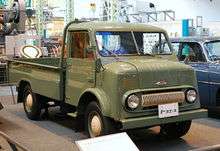 Toyopet Toyoace SKB
Toyopet Toyoace SKB
1956–1959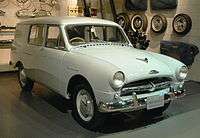 Toyopet Masterline
Toyopet Masterline
1957–1961 Toyopet Publica Convertible
Toyopet Publica Convertible
1963–1968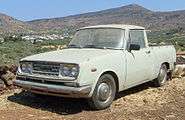 Toyopet Corona Pickup
Toyopet Corona Pickup
(1964 bis 1968) Toyopet Corona Van
Toyopet Corona Van
1965–1970_station_wagon_(2015-11-11)_01.jpg) Toyopet Corona Van
Toyopet Corona Van
1973–1978- Toyopet Crown Station Wagon
1974–1979 - Toyota Carina
1975–1977  Toyota Carina
Toyota Carina
1977–1981_SE_sedan_(2016-01-04)_01.jpg) Toyota Corona Sedan
Toyota Corona Sedan
1978–1981_SE_station_wagon_(2015-06-15)_01.jpg) Toyota Corona Van
Toyota Corona Van
(1978–1982) Toyota Crown Station Wagon
Toyota Crown Station Wagon
1979–1983 Toyota Carina
Toyota Carina
1981–1987_S_station_wagon_(2009-01-16).jpg) Toyota Corona Van
Toyota Corona Van
1982–1987- Toyota MR2
1984–1989 - Toyota MR2
1989–1999 - Toyota Sera
1990–1995 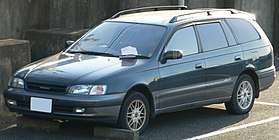 Toyota Caldina
Toyota Caldina
1993–1997 Toyota Caldina Van
Toyota Caldina Van
1993–2002- Toyota Hiace
1993–1996 - Toyota Hiace
1996–2000 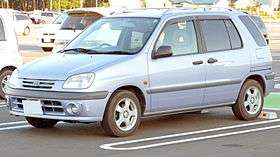 Toyota Raum
Toyota Raum
1997–2003_Spyder_convertible_(2015-08-07)_01.jpg) Toyota MR-S
Toyota MR-S
1999–2007 WiLL Vi
WiLL Vi
2000–2001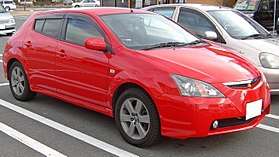 WiLL VS
WiLL VS
2001–2004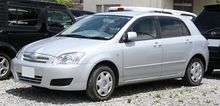 Toyota Allex
Toyota Allex
2001–2007 Toyota Corolla RunX
Toyota Corolla RunX
2001–2007- WiLL Cypha
2002–2005  Toyota Raum
Toyota Raum
since 2003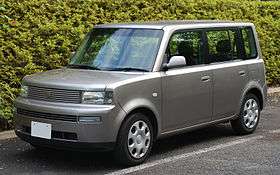 Toyota bB
Toyota bB
2004–2005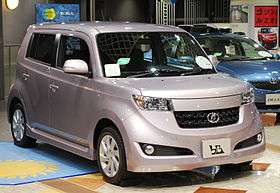 Toyota bB
Toyota bB
2005–2007_Ascent_sedan_(2011-04-02).jpg) Toyota Corolla
Toyota Corolla
2006–2013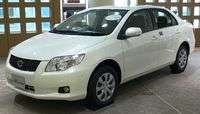 Toyota Corolla Axio
Toyota Corolla Axio
2006–2012 Toyota Belta
Toyota Belta
2007–2012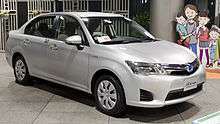 Toyota Corolla Axio
Toyota Corolla Axio
since 2012
Additional models that have no pictures yet:
- Toyota Dyna (1957–1959)
- Toyopet Type FS Ambulance (1961–1968)
- Toyopet Corona Mark Ⅱ PickUp (1968–1971)
- Toyopet Crown Station Wagon (1973–1974)
- Toyopet Corona Van (1970–1973)
- Toyota Carina Surf (1982–1987)
- Toyota Tundra (CKD kits only)
Notes
References
- ↑ Burton, Nigel (2015). "The start of something". Toyota MR2: The Complete Story. Crowood. ISBN 9781847979322.
- ↑ "History of Central Motor". Japan: Toyota Motor East Japan. Retrieved 2018-07-04.
- ↑ "History". Japan: Toyota Motor East Japan Inc. Retrieved 2013-05-26.
- ↑ "Affiliates (Toyota wholly-owned subsidiaries)-Toyota Motor East Japan, Inc". Japan: Toyota. Retrieved 2013-05-26.
- ↑ "Corporate Profile". Japan: Toyota Motor East Japan Inc. Retrieved 2013-05-26.